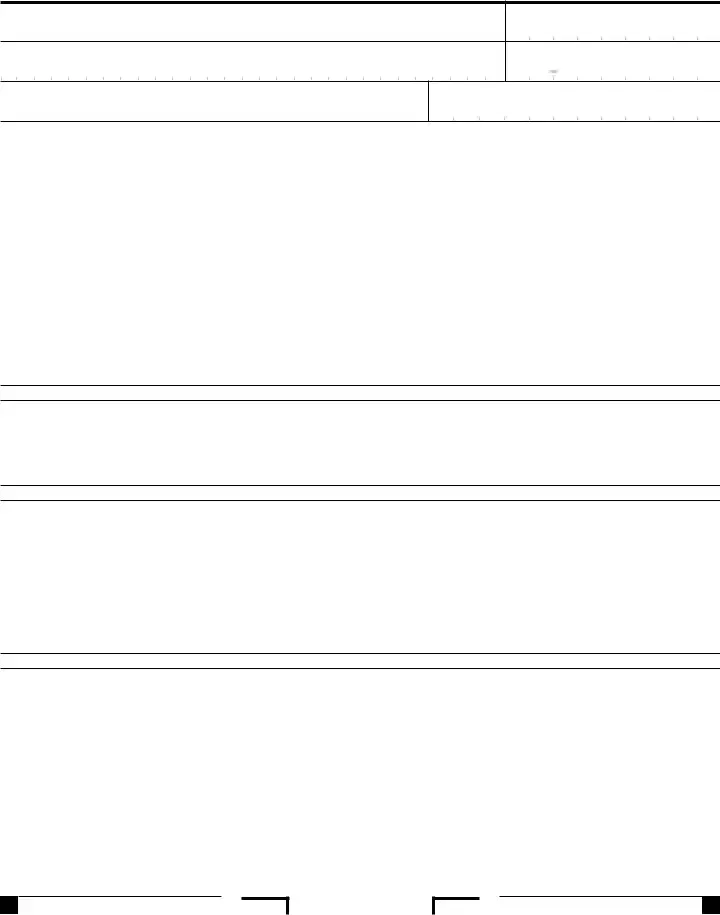California Secretary of State (SOS) file number
A.Check the appropriate box for your entity type:
▐ Individual |
Estate |
Trust |
C corporation |
S corporation Partnership |
Exempt organization |
Limited liability company |
Limited liability partnership |
|
B.Enter the name of the Enterprise Zone (EZ) business: __________________________________________________________________________________
C.Enter the address (actual location) where the EZ business is conducted:
____________________________________________________________________________________________________________________________
D.Enter the name of the EZ in which the business and/or investment activity is located.
____________________________________________________________________________________________________________________________
E. Enter the six-digit Principal Business Activity Code of the EZ Business |
______________________ |
|
Enter the six-digit Principal Business Activity Code from the chart. For the Long Beach |
|
|
EZ, enter the four-digit Standard Industrial Classification (SIC) code number from the chart. |
|
F. |
Total number of employees in the EZ |
______________________ |
G. |
Number of employees included in the computation of the hiring credit, if claimed |
______________________ |
H. |
Number of new employees included in the computation of the hiring credit, if claimed |
______________________ |
I. |
Gross annual receipts of the business |
______________________ |
J. |
Total asset value of the business |
______________________ |
Part I Credits and Recapture (Complete Schedule Z on Side 2 before you complete this part.)
1Hiring and sales or use tax credits claimed on the current year return:
a |
Hiring credit from Schedule Z, line 8A, column (g) or line 10, column (f) |
▐ 1a______________________ |
b |
Hiring credit recapture from Worksheet IA, Section B, line 2, column (b) |
.▐. |
1b______________________ |
c |
Sales or use tax credit from Schedule Z, line 9A, column (g) or line 11, column (f) |
1c______________________ |
d |
Add line 1a and line 1c |
▐ |
1d______________________ |
Part II Business Expense Deduction and Recapture
2 |
a Enter the cost of qualified property purchased for the EZ that is being deducted as a current year |
|
|
business expense from Worksheet II, Section A, line 5, column (b) |
2a______________________ |
|
ELECTION: The act of deducting a portion of the cost of any property as a current year expense rather than adding it |
|
|
to the capital account constitutes an election to treat that property in accordance with R&TC Sections 17267.2 |
|
|
or 24356.7. That election may not be revoked except with the written consent of the Franchise Tax Board (FTB). |
|
|
b Business expense deduction recapture from Worksheet II, Section B, line 2, column (b) |
2b______________________ |
|
|
Part III Net Interest Deduction for Lenders |
|
3 |
Enter the amount of net interest received on loans to businesses located in the EZ from |
|
|
Worksheet III, line 2, column (f) |
3 ______________________ |
Part IV Portion of Business Attributable to the Enterprise Zone
4Enter the average apportionment percentage of your business that is in the EZ from Worksheet IV, Section A,
line 4. If your operation is wholly within the EZ, the average apportionment percentage is 100% (1.00) |
▐ 4 ______________________ |
Part V Net Operating Loss (NOL) Carryover and Deduction |
|
5 a Enter the EZ NOL carryover from prior years from Worksheet V, Section C, line 30, column (b) |
. 5a ______________________ |
bEnter the total EZ NOL deduction used in the current year from Worksheet V, Section C, line 30, column (c). Enter this amount on Schedule CA (540 or 540NR), line 21e, column B; Form 100, line 21;
Form 100W, line 21; Form 100S, line 19; or Form 109, line 6 |
5b______________________ |
c Enter the EZ NOL carryover to future years from Worksheet V, Section C, line 30, column (e) |
5c______________________ |
ELECTION: For those taxpayers eligible for an NOL carryover under R&TC Sections 17276.2, 17276.4, 17276.5, 17276.6, 24416.2, 24416.4, 24416.5, or 24416.6, the act of claiming an NOL carryover on this form constitutes the irrevocable election to apply the loss under R&TC Sections 17276.2 or 24416.2, for taxpayers operating a trade or business within the EZ. If you elect to carry over an NOL under the EZ provisions, you cannot carry over any other type and amount of NOL from this year.


